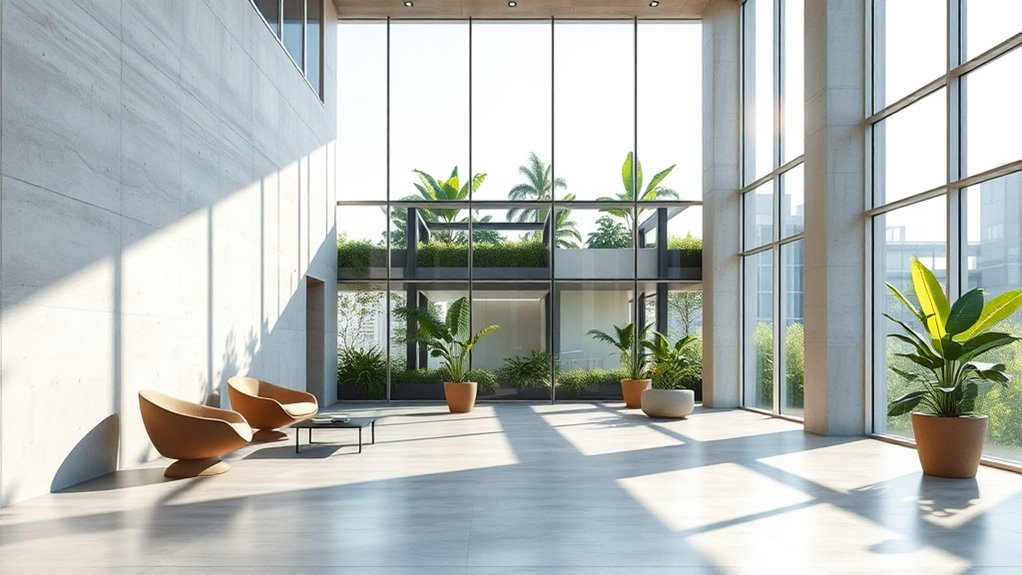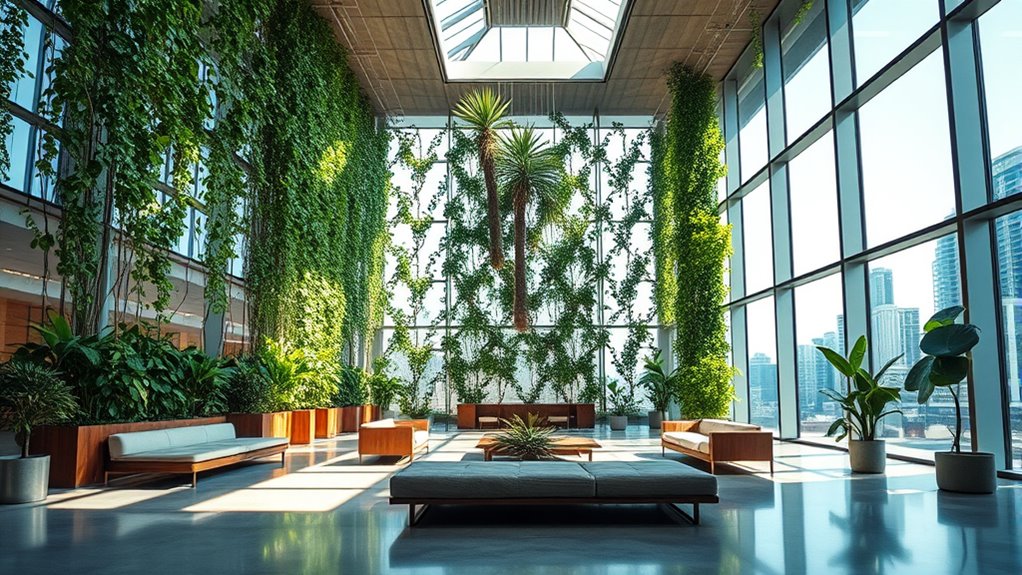Inside the world’s first carbon-negative concrete skyscraper, you’ll discover a structure built with eco-friendly materials like recycled aggregates and bio-based binders, reducing overall emissions. Innovative techniques such as modular construction and 3D printing helped minimize waste and energy use. The building features water-saving systems, renewable energy sources, and green roofs that boost insulation and air quality. To uncover how these sustainable strategies transform urban tall buildings, keep exploring this groundbreaking project.
Key Takeaways
- The skyscraper utilizes sustainable, recycled, and bio-based materials to achieve a carbon-negative footprint.
- Innovative construction methods like prefabrication and 3D printing reduce waste and energy consumption.
- On-site renewable energy systems and water conservation strategies enhance the building’s environmental performance.
- Design features such as green roofs and vertical gardens improve insulation and air quality while supporting sustainability.
- The project exemplifies how eco-friendly materials and tech can redefine skyscraper standards toward a greener future.

While skyscrapers often symbolize urban progress, the world’s first carbon-negative concrete skyscraper proves that sustainable innovation can also reach new heights. This groundbreaking project demonstrates how you can combine architectural ambition with environmental responsibility by utilizing sustainable materials and innovative construction techniques. Instead of relying on traditional concrete, which is notorious for its high carbon footprint, the designers incorporated alternative, eco-friendly materials that markedly reduce emissions. These sustainable materials include recycled aggregates, bio-based binders, and carbon-sequestering additives, all carefully selected to lower the building’s overall impact. By choosing such materials, you’re part of a movement that challenges the conventional approach to skyscraper construction and pushes for a greener future.
The process of innovative construction plays a vital role in achieving these goals. Techniques like modular building, 3D printing, and prefabrication allow you to streamline the construction timeline, minimize waste, and reduce energy consumption during assembly. These methods also enable precise control over material use, ensuring that every component contributes to the building’s sustainability. The skyscraper’s innovative construction process incorporates on-site renewable energy systems, like solar panels and wind turbines, further decreasing reliance on fossil fuels. Additionally, the integration of rainwater harvesting and greywater recycling systems helps conserve water resources, making the building more self-sufficient. Incorporating vertical storage solutions can also optimize space and decrease clutter, enhancing the building’s functional design. Implementing sustainable building practices has become essential in advancing environmentally responsible architecture. Moreover, advancements in building materials play a crucial role in reducing the ecological footprint of such structures. Staying informed about building codes and standards ensures your projects meet environmental and safety requirements. You can also explore how eco-friendly construction techniques are influencing the industry’s shift towards sustainability.
Inside this skyscraper, you’ll find a host of features designed to maximize its environmental performance. Smart building management systems monitor energy use and optimize lighting, heating, and cooling to minimize waste. Green roofs and vertical gardens not only enhance aesthetics but also improve air quality and insulation, reducing the building’s overall energy demand. These sustainable strategies demonstrate how you can design with intention, ensuring that every element contributes to the building’s carbon-negative purpose.
This project proves that sustainable materials and innovative construction aren’t mutually exclusive—they work together to create structures that are both functional and eco-friendly. By adopting cutting-edge techniques and eco-conscious materials, you’re helping to redefine what’s possible in urban architecture. The skyscraper stands as a testament to how you can challenge industry norms, demonstrate leadership in sustainability, and inspire a new generation of construction that’s mindful of its environmental footprint. Ultimately, this achievement shows that reaching new heights doesn’t have to come at the planet’s expense; instead, it can be part of a solution that benefits everyone.
Frequently Asked Questions
What Is the Construction Timeline for the Skyscraper?
You want to know the construction timeline for the skyscraper, focusing on the milestones and timeline phases. Typically, the project starts with planning and design, followed by foundation work, structural framing, and exterior finishes. The timeline progresses through interior fit-outs and systems installation, ending with testing and final inspections. Each phase has specific milestones that make certain the project stays on track, culminating in completion within the projected timeframe.
How Does the Building’S Energy Performance Compare to Traditional Skyscrapers?
Imagine a future where your skyline breathes easier. This skyscraper’s energy performance surpasses traditional buildings by seamlessly integrating renewable energy sources, reducing emissions considerably. Its innovative design supports smarter urban planning, making cities healthier and more sustainable. You’ll notice lower energy costs and a smaller carbon footprint, all while enjoying modern comforts. It’s a shining example of how forward-thinking architecture can harmonize with the environment, setting new standards for urban living.
What Materials Are Used Besides Carbon-Negative Concrete?
You’ll find that besides carbon-negative concrete, the building uses recycled metals for structural elements, reducing environmental impact. It also employs innovative insulation materials that improve energy efficiency further. These choices help cut down emissions and boost sustainability. By combining recycled metals and advanced insulation, the skyscraper minimizes its carbon footprint while maintaining strength and comfort, making it a true example of eco-friendly construction.
How Is the Building Maintained to Ensure Ongoing Sustainability?
While the building appears sleek and modern, its maintenance protocols are carefully designed to sustain its eco-credentials. You guarantee regular inspections and upgrades align with sustainability certifications, like LEED, and monitor energy and water efficiency. You also use eco-friendly cleaning methods, minimizing environmental impact. By staying proactive, you help preserve the skyscraper’s carbon-negative status, demonstrating that ongoing commitment and mindful upkeep are key to maintaining true sustainability.
What Are the Future Plans for Expanding This Technology Globally?
You’re curious about how this innovation might grow globally. To achieve this, scaling strategies focus on adapting sustainable materials and construction methods to different regions. International adoption depends on collaboration between governments, industry leaders, and communities to promote eco-friendly building practices. By sharing technology and expertise, you can help accelerate the spread of carbon-negative skyscrapers worldwide, making sustainable urban development a standard rather than an exception.
Conclusion
Imagine a future where buildings breathe as easily as trees. This skyscraper proves that sustainability isn’t just a dream but a reality we can build—literally. By choosing carbon-negative concrete, you’re not just constructing a structure; you’re shaping a legacy of environmental stewardship. Don’t let this innovation slip by unnoticed. It’s a beacon guiding us toward a greener tomorrow—showing that even the tallest towers can stand tall against climate change.
Amina brings over a decade of journalism experience to her role as Editor-in-Chief. Under her leadership, Exquisite Post has flourished, maintaining the highest standards of integrity and excellence. Amina’s commitment to truth and her visionary approach guide the editorial team in producing impactful news stories that resonate with our audience.










